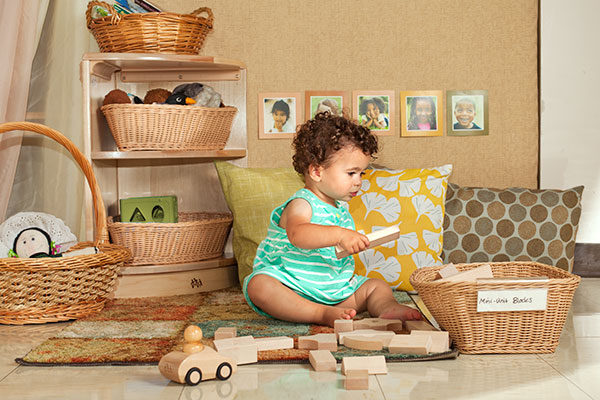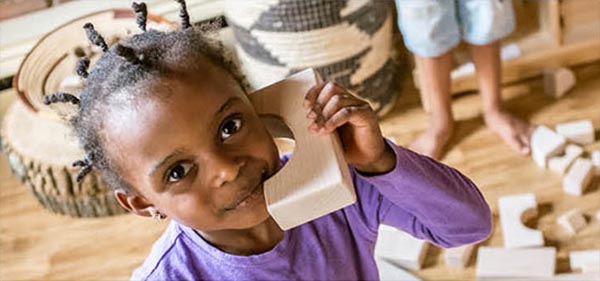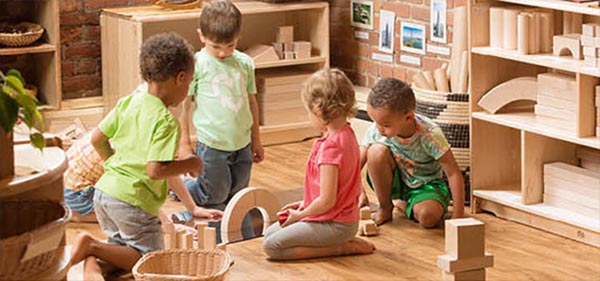Author of Blocks Back in the Spotlight Again
Every bit I load up my trunk with containers of blocks and institute materials in preparation for all the same another training for early childhood teachers, I tell myself that I am getting too old for all this schlepping. Merely as apace as the thought crosses my listen, a surge of excitement and free energy pulses through me. Afterwards half-dozen years of facilitating professional evolution sessions on the exploration of materials with teachers, I am more than convinced than ever that blocks are ane of the most essential materials for the early childhood classroom.

"Why then, in the name of school readiness, is block play marginalised, if not disappearing from children's classrooms?" asks Margie Carter in the foreword to Artistic Cake Play (Hansel 2017). Increasingly, young children today are sitting in front end of two-dimensional screens and worksheets instead of having playful, hands-on, sensory experiences with three-dimensional objects (Hansel 2015). Why is this a problem and what is information technology about blocks, and wooden unit blocks in detail, that brand them such an of import cloth for young children?
The science of block play, maths and shapes
Many early on childhood experts, including Friedrich Froebel, Caroline Pratt, Harriet Johnson, Elizabeth Hirsch, and Mary Jo Pollman, accept documented the value of blocks for children's learning, offering evidence that when children are given fourth dimension to plan, construct, and create with blocks, they develop socially, emotionally, cognitively, and physically (Hansel 2017, 5). This evidence is now being confirmed by scientists using new technologies to come across the inner workings of the encephalon.
According to Dr. Jo Boaler, a professor of mathematics instruction at Stanford University, brain research now shows that every bit you learn something deeply, the synaptic action in the brain volition create lasting connections (dissimilar when you learn something in a superficial way) and that "synapses fire when we have conversations, play games, or build with toys" (Boaler 2016, 1). In other words, edifice with blocks to experience their 3-dimensional properties will create a lasting pathway in the encephalon and a deeper understanding of shape, whereas identifying three dimensional shapes on a workbook page is unlikely to build understanding of shape and 3-dimensionality.

The importance of spatial skills
In addition, in that location is heady new evidence linking good spatial skills and children's future achievement in all the STEM (Science, Technology, Engineering and Mathematics) subjects (Lubinski 2013; Newcombe 2010). "Despite the prove, however, the importance of spatial skills is often overlooked as a primal characteristic of Stem education. This frequent neglect of spatial development creates an boosted barrier to children's Stalk learning" (Berkowicz and Myers 2017) and reminds those of us in early childhood education that we must offset paying attention to developing spatial skills. While laying the foundation in the STEM subjects is of import, particularly for underserved populations and those underrepresented in the STEM fields, including girls, spatial skills are disquisitional in many other fields, equally well equally in everyday life, such every bit when we load up a trunk with blocks and navigate our way to a new location for the beginning time.
The swell news is that spatial skills can exist improved with practise. While not all experts agree on a common definition of what spatial skills are (Hansel 2017, xx), almost agree that the use of manipulatives helps children make sense of abstract concepts. Wooden unit blocks are a perfect example of a child-friendly manipulative that tin be used to strengthen spatial skills. Think near how a kid recreates a zoo with blocks while closely referring to a map of the zoo and carefully ensuring that each zoo animal fits into the enclosures she has made to scale.
Which block activities foster spatial skills?
Start with giving children aplenty fourth dimension for open-ended exploration with blocks, but don't stop at that place. If you really want to see children's spatial thinking flourish, target the spatial skills in the table below and offering cake activities that encourage spatial language and challenging tasks! Now the spotlight is on you!

| Block activity | Spatial Skill |
|---|---|
| Constructing with blocks | Transforming shapes by rotating, sliding or flipping them (making as many combinations as possible through manipulation) |
| Filling containers with blocks; filling enclosures with objects | Learning to judge capacity and book. How many tin fit into the container? Does the object fit into the enclosure? |
| Fitting blocks together and taking them apart | Decomposing (part-whole integration, which involves seeing the shapes embedded in other shapes and seeing them equally a whole) |
| Changing the shape and arrangements of blocks by stacking or enclosing | Composing (physically or mentally combining shapes to make unlike shapes) |
| Observing block constructions from different viewpoints, such as from to a higher place, from behind or in front of a mirror | Perspective-taking (considering the perspective of someone who is in a dissimilar location and how that view might be unlike from yours) |
| Describing positions, directions and distances such equally outside, within, over and under while building | Using spatial language in context |
| Building on the floor or outdoors | Moving one'south body in space |
| Using blocks to stand for other objects | Representing symbolically one object for some other |
| Interpreting spatial relations in drawings, pictures and photos | Using non-verbal reasoning. Seeing connections between three-dimensional objects and 2-dimensional representations |
| Drawing 3 dimensional constructions or reproducing real-life structures | Understanding spatial relationships and reinforcing visual-spatial retentivity |
| Comparison and measuring the size, shape, thickness, length and tiptop of blocks | Comparing objects. Scaling up or down (imagining objects or amounts as proportionally larger or smaller) |
| Making a model from a map or blueprint | Visually interpreting maps and blueprints |
| Building a bridge | Learning to judge the distance between objects |
| Designing with blocks | Creating patterns (radial, linear, symmetrical tessellations) |
| Playing hibernate and seek with blocks | Locating and remembering locations of objects |
| Putting blocks back on the shelves (marked with the shape of the blocks) | Classifying, sorting and sequencing shapes |

References
Berkowicz, Jill and Myers, Ann. "Spatial Skills: A Neglected Dimension of Early Stem Education." Retrieved on June 27, 2017 here.
Boaler, Jo. 2016. Mathematical Mindsets: Unleashing Students' Potential through Creative Math, Inspiring Messages and Innovative Instruction. San Francisco, CA: Jossey-Bass.
Hansel, Rosanne. 2017. Creative Cake Play: A Comprehensive Guide to Learning through Building. St. Paul, MN: Redleaf Press.
Hansel, Rosanne. 2015. "Bringing Blocks Back to the Kindergarten Classroom." Young Children lxx (i):44-51.
Lubinski, David. 2013."Early Spatial Reasoning Predicts Later Creativity and Innovation, Peculiarly in STEM Fields." Science Daily. July xv.
Newcombe, Nora. 2010. "Picture This: Increasing Math and Scientific discipline Learning past Improving Spatial Thinking." American Educator, Summer 2010, 29-43.
Pollman, Mary Jo. 2010. Blocks and Beyond: Strengthening Early on Math and Scientific discipline Skills through Spatial Learning. Baltimore, MD: Brookes.
Source: https://www.communityplaythings.co.uk/learning-library/articles/blocks-back-in-the-spotlight-again
0 Response to "Author of Blocks Back in the Spotlight Again"
Postar um comentário